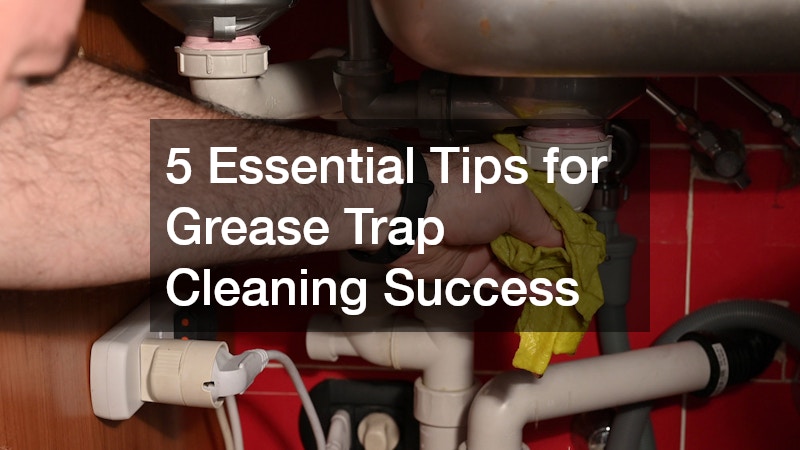Grease traps play a vital role in maintaining the functionality and hygiene of commercial kitchens, restaurants and food service establishments. Designed to separate fats, oils and grease (commonly referred to as FOG) from wastewater, these devices prevent blockages in plumbing systems and protect local water supplies from contamination. However, simply having a grease trap installed is not enough—regular and effective maintenance is key to avoiding costly repairs and operational shutdowns. Understanding how to carry out grease trap cleaning correctly can save time, money and headaches. Here are five essential tips to help ensure success with your grease trap cleaning routine.
Understand Your Grease Trap’s Capacity & Usage
One of the first steps towards successful grease trap cleaning is knowing the size and capacity of your unit, along with how heavily it is used. Different establishments generate varying levels of grease and food waste depending on their menu, kitchen practices and volume of service. A small café that serves light fare may not need cleaning as often as a high-volume restaurant with fried foods on the menu. Understanding this helps determine the appropriate cleaning frequency, which is crucial for keeping the trap functional. If a grease trap is neglected or overwhelmed, it can lead to overflow, bad odours and even violations of local environmental regulations. By tracking usage and waste levels, kitchen staff and maintenance crews can develop a cleaning schedule that prevents build-up and maintains compliance with health standards.
Follow a Consistent Cleaning Schedule
Consistency is everything when it comes to grease trap maintenance. A one-off clean every few months is not sufficient for busy commercial kitchens. In fact, waiting until problems arise usually means the trap has already reached a critical level of grease accumulation. A recommended rule of thumb is the “25 per cent rule”—when the trap is a quarter full of FOG, it is time for a clean. Scheduling professional or in-house cleaning at regular intervals—whether fortnightly, monthly or bi-monthly—ensures the system runs smoothly and remains odour-free. Keeping a logbook of cleaning dates and inspection notes not only helps stay organised but also provides evidence of compliance in case of a health inspection.
Use the Right Tools & Techniques
Proper grease trap cleaning requires the right tools and techniques to be effective. Manual cleaning involves opening the trap, scooping out solidified grease and scrubbing internal components to remove residue. Using a shop vacuum or wet/dry vac can help with the removal of liquid waste, while scrubbing tools like wire brushes are useful for breaking down hardened grime on trap walls. It is essential to avoid using hot water or chemical cleaners that might melt the grease temporarily but cause it to solidify further down the pipeline, creating future blockages. Instead, cold water and non-toxic degreasers are preferable for safe and thorough cleaning. Hiring trained professionals with specialised equipment can also ensure a deeper and more hygienic result, particularly for larger commercial systems.
Train Staff on Grease Management Practices
Even with a regular grease trap cleaning schedule in place, kitchen practices greatly influence the volume of grease that ends up in the system. Staff training is a key component in reducing FOG buildup. Employees should be instructed to scrape food scraps into bins before washing, avoid pouring oil or grease down the sink and clean filters in ventilation systems frequently. Installing sink strainers to catch solids and using collection bins for used oil also contributes to reducing the burden on the grease trap. When staff understand how their day-to-day activities affect the plumbing system, they are more likely to adopt habits that support long-term efficiency and cleanliness. A proactive approach to grease management in the kitchen is often the simplest way to extend the lifespan of the grease trap.
Work with a Professional Grease Trap Cleaning Service
While some businesses may choose to handle grease trap maintenance in-house, there are clear advantages to engaging a professional service. Certified providers are familiar with council regulations and disposal requirements, ensuring that waste is handled legally and responsibly. They can offer detailed reports, identify early warning signs of potential issues and recommend improvements to your current system. Professional cleaners also have access to advanced tools that make the job quicker and more effective than manual methods. By outsourcing this responsibility, business owners and managers free up internal resources, maintain compliance and enjoy peace of mind knowing the job is being done thoroughly. Furthermore, regular service agreements can lock in convenient appointments and keep cleaning on schedule.
Consistency & Care Are Key to Grease Trap Success
A well-maintained grease trap is critical to keeping commercial kitchens clean, functional and compliant with health and safety standards. When ignored, grease traps can cause foul odours, plumbing issues and costly disruptions to business operations. By understanding the trap’s capacity, maintaining a consistent cleaning schedule, using appropriate tools, educating staff and partnering with professional services, food service businesses can stay ahead of problems and protect their reputation. Grease trap cleaning is more than just a chore—it is a fundamental part of responsible kitchen management. Prioritising this routine ensures your operations remain hygienic, efficient and in line with council and environmental regulations.


